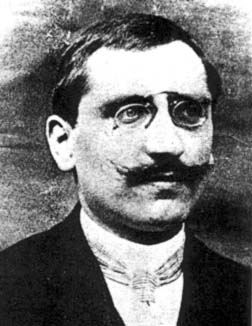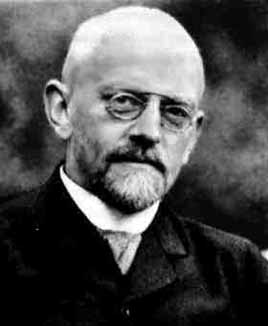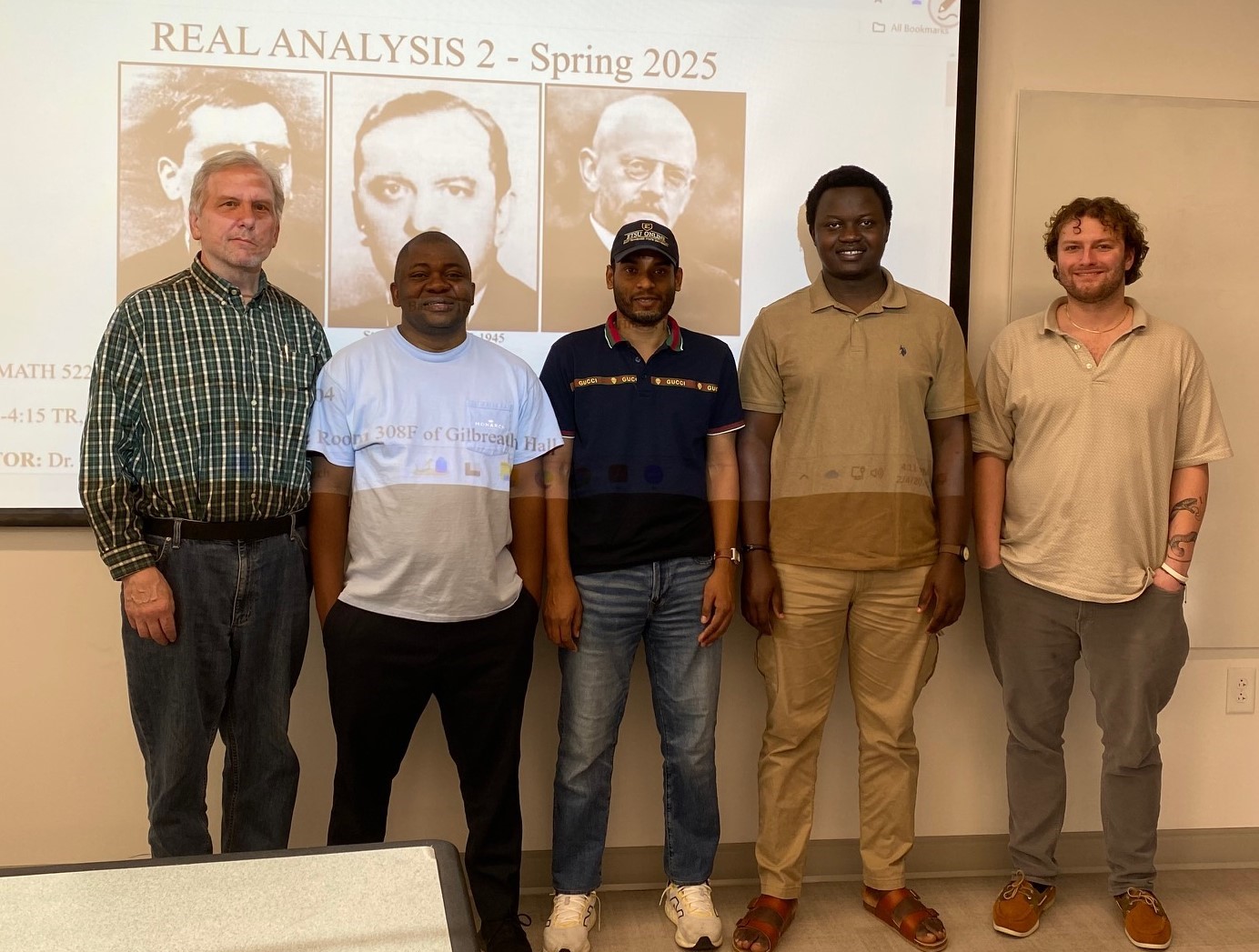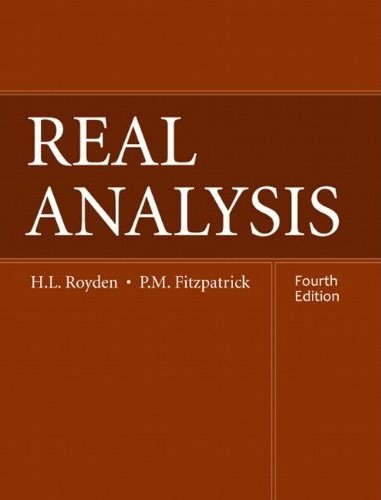 Henri Lebesgue, 1875-1941 |
 Stefan Banach, 1892-1945 |
 David Hilbert, 1862-1943 |
 Henri Lebesgue, 1875-1941 |
 Stefan Banach, 1892-1945 |
 David Hilbert, 1862-1943 |

COURSE: MATH 5220-001 (12401)
TIME: 2:55-4:15 TR, PLACE: Gilbreath Hall 104
INSTRUCTOR: Dr. Robert Gardner, OFFICE: Room 308F of Gilbreath Hall
OFFICE HOURS: 4:15-5:00 TR in Gilbreath 104 (as needed), PHONE: 439-6979 (Math Office 439-4349)
E-MAIL: gardnerr@etsu.edu
WEBPAGE: Dr. Bob's faculty webpage
TEXT: Real Analysis, Fourth Edition, by H.L. Royden and P.M. Fitzpatrick, Prentice Hall (2010).

PREREQUISITE: Real Analysis 1 (MATH 5210).
CLASS NOTES: We will use digital notes for the component of the lecture consisting of definitions, statements of theorems, and some examples. Proofs of the vast majority of theorems, propositions, lemmas, and corollaries are available and in Beamer presentations and will be presented in class as time permits. Limited marginal notes, additional examples, and further explanations will be given using handwritten notes and a document camera. Class notes are online, based on the three parts of the book: Part 1, Part 2, and Part 3. You should read the online notes to be covered in class before each class (we may not have class time to cover every little detail in the online notes). Try to understand the definitions, the examples, and the meanings of the theorems.
ZOOM AND ATTENDANCE: A Zoom meeting and recording of each class will be available. However, you are expected to attend in-person! In-person attendance will be informally taken during each class. If you are not feeling well or for other reasons cannot attend, let me know before class starts. The recordings will be available (if all of the technology works) and you can view them (or re-view them) as needed.
ABOUT THE COURSE: We will build on the results of Real Analysis 1. We will cover, to some extent, Banach spaces and Hilbert spaces (Chapters 7 and 8), though these are topics more appropriately covered in a functional analysis class. We will cover additional topics, depending on class interest. We can cover metric spaces (Chapters 9 and 10) and/or topological spaces (Chapters 11 and 12), general measure and integration (Chapter 17, 18, and 20). The fourth edition of Real Analysis states on page x that "The general theory of measure and integration was born in the early twentieth century. It is now an indispensable ingredient in remarkably diverse areas of mathematics, including probability theory, partial differential equation, functional analysis, harmonic analysis, and dynamical systems. Indeed, it has become a unifying concept."
GRADING: Homework will be assigned on a regular basis (weekly) and your grade on the homework will determine your grade for the course (so there are no tests!). Grades will be assigned based on a 10 point scale with "plus" and "minus" grades being assigned as appropriate (which means, based on how the university assigns grade points, 3 point intervals for plus and minus grades - for example, an A- corresponds to percentage grades of 90, 91, and 92). Remember that the lowest passing grade in a graduate course is a C, so you need an average of 73% on all assignments in order to pass this class.
HOMEWORK: Homework will be assigned and collected at one week intervals. It will normally be due on Saturdays at midnight and you will be expected to submit scans in PDF of your work to D2L (so you will need a way to convert your solutions into PDF versions, either with a scanner of a phone APP). YOU MUST SHOW ALL DETAILS ON THE HOMEWORK PROBLEMS!!! Justify every step and claim you make - this is how you convince me that you know what you are doing. You may find some answers online, but these rarely sufficiently justify all steps and are unacceptable as homework solutions.
ACADEMIC MISCONDUCT: If you have any questions about the assigned homework problems, then I will try to address them in class. If you need additional information, then let me know. We can work it out through e-mail, Zoom, or in-person meetings in my office. You are not to collaborate with your classmates on homework! I expect that the work you turn in is your own and that you understand it. Some of the homework problems are fairly standard for this class, and you may find proofs online or proofs generated by a Generative Artificial Intelligence (such as mathgpt). The online proofs or AI generated proofs may not be done with the notation, definitions, and specific methods which we are developing and, since they are not your work, they are not acceptable for this class. If I get homework from two (or more) of you that is virtually identical, then neither of you will get any credit on that assignment. If you copy homework solutions from an online source, then you will get no credit. If your homework is identical to one of your classmates, with the exception of using different symbols/variables and changing "hence" to "therefore," then we have a problem! If you copy a solution from a solution manual or from a website or use AI, then we have a problem! I will not hesitate to charge you with academic misconduct under these conditions. To avoid this, do not copy homework and turn it in as your own!!! These are examples of academic misconduct and I will have to act on this as spelled out on ETSU's "Academic Integrity @ ETSU" webpage (last accessed 1/16/2025). When such a charge is lodged, the dean of the School of Graduate Studies is contacted. Repeated or flagrant academic misconduct violations can lead to suspension and/or expulsion from the university (the final decision is made by the School of Graduate studies and the graduate dean, Dr. McGee).
DESIRE2LEARN: I will not rely on the Desire2Learn ("elearn") website for classnotes or supplements. Instead, I will simply post this material directly on the internet. However, I will post your homework grades, homework solutions, and recordings of class lectures on D2L.
SYLLABUS ATTACHMENT: You can find an on-line version of the university's syllabus attachment (which contains general information concerning advisement, honor codes, dropping, etc.; last accessed 1/16/2025).
CAMPUS SAFETY: East Tennessee State University is dedicated to creating a safe and healthy environment for all students, faculty, staff, and visitors by fostering a strong culture of safety that extends beyond compliance with regulations. All members of the ETSU community play a crucial role in this shared responsibility. You are encouraged to report any issue without fear, ensuring a supportive environment. As Buccaneers, make safety a priority and contribute to a positive, productive campus community by:
TENTATIVE OUTLINE:
6.6. Convex Functions and Jensen's Inequality.
Chapter 7: The Lp Spaces: Completeness and Approximation.
Lp spaces, Minkowski and Holder Inequalities, convergence and
completeness, Banach spaces, Riesz-Fischer Theorem, approximation, and separability.
Chapter 8: The Lp Spaces: Duality and Weak Convergence.
Bounded linear functionals, Riesz Representation Theorem, dual spaces, weak convergence.
Hilbert Spaces.
Hamel and Schauder bases, inner product spaces, completeness, projections, Hilbert spaces Isomorphisms, the Fundamental Theorem of Infinite Dimensional Vector Spaces.
Chapters 9 and 10: Metric Spaces. (Maybe)
Open sets, sequences, continuity, complete metric spaces, compact metric spaces, separable metric spaces, Arzela-Ascoli Theorem, Baire Category Theorem, Contraction Principle.
Chapters 11 and 12: Topological Spaces. (Maybe)
Open sets, bases, subbases, separation properties, continuity, compact tological spaces, connected topological spaces, fundamental theorems.
Chapters 17, 18, and 20: General Measure and Integration. (Maybe)
Measure spaces, signed measure, outer measure, Caratheodory measure, measurable functions and their integration, Radon-Nikodym Theorem, product measures, Lebesgue measure on ℝn, Hausdorff Measures on a Metric Space.
IMPORTANT DATES: (see the official ETSU calendar for more details; accessed 8/18/2024):
| |
|
|||
| |
||||
| |
||||
| |
||||
| |
Section 7.3. Lp is Complete: The Riesz-Fischer Theorem |
7.26 |
||
| |
Section 7.4. Approximation and Separability |
7.36, 7.37 |
||
| |
||||
| |
||||
| |
HWG Section 5.4. Projections and Hilbert Space Isomorphisms |
|||
| |
||||
| |
||||
Return to Bob Gardner's home page
Last updated: April 24, 2025